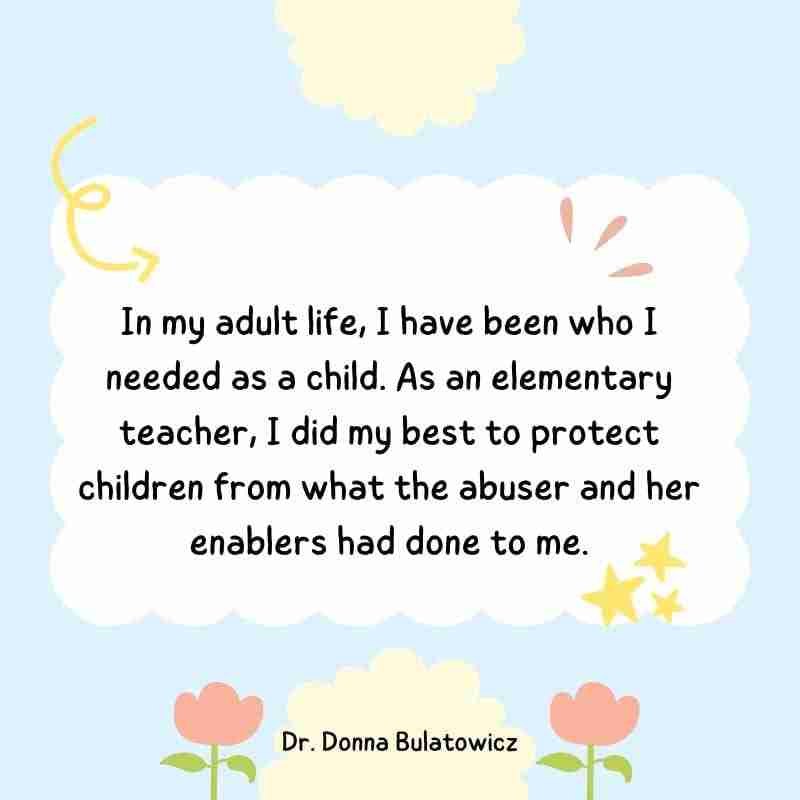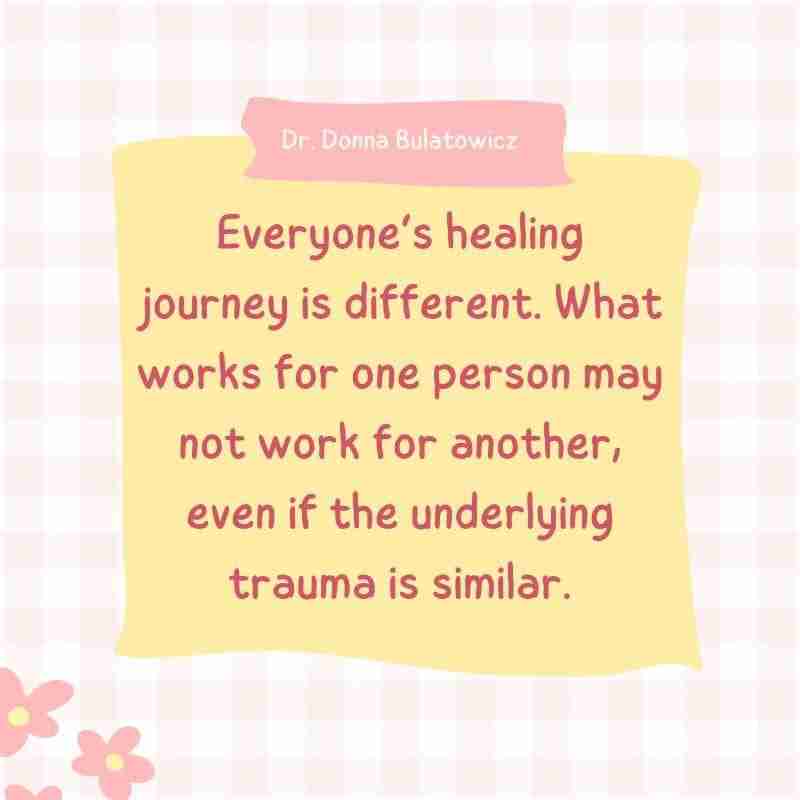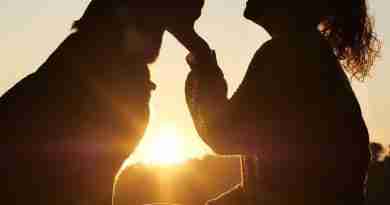Healing From Childhood Trauma: A Long Journey to Finding Myself
I started out as a bewildered traveler when I embarked on my journey of healing from childhood trauma in August 2022. I had no idea what it would involve. There was no map and only a vague impression of my destination.
Let’s just say I took the meandering, scenic route.
I didn’t understand what healing truly entailed. In the beginning, I thought it meant that I would no longer have any impacts from the sexual abuse.
While that’s a nice idea, it’s unrealistic to think that childhood trauma would no longer affect me at all. I was still in denial about how much it impacted me, including the damage to my brain, nervous system, body, and DNA.

Hiding from the Effects of Childhood Trauma
For decades, I shoved the abuse away almost every time it entered my conscious thinking.
The child psychologist I saw after I told on my abuser claimed that I was fully healed from the sexual abuse after about a year of talk therapy, even though I still had symptoms of post-traumatic stress disorder, anxiety, depression, and other signs of unhealed childhood trauma.
She hadn’t let me talk about the worst traumatic events, as the only way I could figure out how to explain some of the things my abuser did was to use the dolls in her office. I didn’t have the language to describe the flashbacks. She refused to allow me to do that and told me to “use [my] words like a big girl.”
Needless to say, her proclamation that I had overcome the abuse was wrong. But I believed her, and I assumed that if I thought about it or had flashbacks or other symptoms of post-traumatic stress disorder, it meant that I failed.
I didn’t want to be any more of a failure than I already imagined I was. I didn’t yet realize that my low self-esteem, physical health (e.g. long COVID), and other symptoms showed I had unresolved childhood trauma.
My coping mechanisms were automatic after so many years in survival mode. I dissociated from my body, as that made getting through life easier. My body was the crime scene, and I didn’t like being present in it.
I focused on others as a coping strategy. I found it easier to throw myself into my career than be present with myself and slow down enough to notice that I needed to heal.

In my adult life, I have been who I needed as a child. As an elementary teacher, I did my best to protect children from what the abuser and her enablers had done to me. However, I didn’t spend any time considering that I might still need to heal.
Starting the Journey to Heal from Childhood Trauma
I gave and gave until it depleted me. I did the same during my doctoral work. Then again, as a university educator. I ran on a near-constant state of burnout and survival. That made it easier for me to act as though the sexual abuse didn’t still impact me.
In June and July of 2022, I started having dreams about the abuser that became more frequent. Flashbacks began again, and I no longer had the resources to shove them aside.
Long COVID had altered my way of being in the world and my coping strategies.
I no longer had the energy that I used to, and I couldn’t hide the impacts of the childhood trauma anymore without impacting my mental health.
I realized I still needed to overcome childhood trauma, and I started the healing journey, fumbling and without proper supplies. Thank goodness I was already in cognitive behavioral therapy to cope with the impacts of Long Covid as well as discrimination at my workplace.
I turned to my therapist to help me navigate this terrain.
Healing Childhood Trauma Looks Different for Everyone
Everyone’s healing journey is different. What works for one person may not work for another, even if the underlying trauma is similar.

We each have different identities, nervous systems, brains, mental health, frames of reference, and thus interpretations of experiences. There is much nuance that informs the impact of a traumatic event on an individual, especially when it happens in childhood.
Of course, the type of event matters. Some tend to be traumatic for almost all people. However, the way it impacts an individual depends on a variety of factors.
If the person has a strong support system that provides care in the aftermath of the traumatic incident, that can decrease the impact.
Developmental stages play a role also. Experiences that happen during infancy shape the brain in different ways than events in middle childhood or later ages.
Early childhood trauma tends to have a lasting impact on the brain, body, nervous system, and more due to all that is happening developmentally during this crucial time.
Impact of Chronic Trauma and the Role of Healthy Relationships in Healing
Healthy relationships and strong attachments help children heal more from traumatic experiences.
Whether trauma occurs once or repeatedly matters as well. Chronic trauma tends to have greater effects than one-time trauma. Chronic trauma includes emotional, physical, or sexual abuse, as well as physical and emotional neglect.
A prior relationship between an abuser and victim also plays a role. Betrayal, relational, and emotional trauma create additional damage, including low self-esteem, mental health disorders, self-destructive behaviors, substance abuse, challenges with emotional regulation, unhealthy coping strategies, physical reactions, emotional dysregulation, difficulties maintaining healthy relationships, and more.
Genetics as well as earlier experiences have already shaped the brain and may have primed it for sensitivity to additional childhood trauma. Those who experienced earlier abuse may feel that additional abuse is similar, familiar, and/or expected and may react differently than someone who has not.
Oppression, discrimination, and other forms of institutional, societal, and individual traumatization also play a role. Trauma layered on top of trauma tends to cause more harm than single-episode traumatic events, though, of course, everyone’s experiences are different.
There is No “Wrong” Way to Heal from Adverse Childhood Experiences
I had not thought much about any of this at the commencement of the journey toward healing childhood trauma. Thus, I did what was programmed into me at a young age; I compared myself unfavorably to others and thought I was doing healing “wrong.”
It took time for me to understand that just because my journey of healing from childhood trauma was different, it didn’t mean I was doing anything wrong.

I was creating the path that was best for me based on the childhood traumas that I experienced and the complex post-traumatic stress disorder and other challenges the traumatic events caused.
While each of us who embarks on a healing journey has a unique path, there are commonalities. Typically, therapy of some sort provides numerous benefits, especially from trauma-informed mental health professionals.
Various Types of Therapy Helped in My Healing Process
In my case, talk therapy, cognitive behavioral therapy, EMDR, and somatic therapy help me deal with the effects of myriad adverse childhood experiences. Each type of therapy has provided me with specific benefits and helped me work on overcoming childhood trauma.
This healing process takes time, as treating childhood trauma is complicated.
Talk therapy that included spirituality helped me share various parts of my story and hold onto hope.
Hope not only improves mental health, it also provides something to hold onto when parts of the healing journey are challenging and painful.
Spirituality helps me put things into perspective and transmute the trauma into something better.
Holding Compassion for the Abuser
It’s also allowed me to hold compassion for the traumatic experiences and mental health disorders the abuser suffered while holding her accountable as best as I could for the harm she caused.
Since she passed away over a decade ago, this accountability looks very different than it would if she was still alive.
Her trauma explains her behavior but does not excuse the choices she repeatedly made to traumatize others, including by committing many felonies. As far as I know, she did not have any treatment for the childhood trauma she told me about.
As I gained more knowledge about the impacts of childhood trauma, I started to see that the abuser continued to suffer from the effects of severe abuse during her childhood.
I’m fairly certain that her mental health conditions, substance abuse issues, emotional dysregulation, and more were symptoms of trying to function after experiencing severe childhood trauma—assuming that what she told me was true.
Understanding this helps me hold compassion for her, and I believe that in time I will likely forgive her.
The focus of my journey is on my own healing. However, compassion naturally arises from time to time as I learn more about the impacts of adverse childhood experiences and see much of what I know about her behaviors, etc., in what I learn.
It fascinates me how differently people respond to childhood trauma; she and I both experienced various types of abuse. She became a child abuser, and I became determined to protect others, like most survivors of sexual abuse.
Self Compassion is an Essential Component of Healing from Childhood Trauma
Talking about various aspects and incidents of the sexual, physical, and emotional abuse helped me move through the tremendous shame and guilt that the abuser pushed onto me, but which always belonged to her.
I’ve handed most of the weight of the emotional pain back to her as I’ve made progress on the journey toward overcoming childhood trauma.
Having a therapist compassionately hear me and see me in a safe and supportive environment allowed me to start practicing self-compassion. Cultivating self-compassion has taken what feels like eons, as it’s been a huge challenge for me.

I can easily feel compassion for others. Finding ways to apply that to myself has taken much practice, and it’s something I’ve failed at, tried again, messed up, and practiced more. I’m still working on that and self-love, but I have much more than I did at the start of this journey.
EMDR has allowed me to integrate traumatic memories. The brain forms and stores traumatic memories differently from non-traumatic memories.
The way these memories are stored and retrieved can result in flashbacks with time confusion, where it can feel as if the memory is happening again. The pain, terror, and panic associated with flashbacks may feel overwhelming.
EMDR helps resolve that, allowing the memory to be stored differently in the brain. It’s a slow process and working on one memory—or a series of similar memories—can take several therapy sessions.
I often felt so drained after a session that I needed time to rest. I practiced deep breathing exercises, emotional regulation, and other healthy coping skills, as well as reached out for emotional support from loved ones after each EMDR session.
Somatic therapy has allowed me to become more present in my body. It’s challenging to be fully in the body when the body was the scene of a crime.
However, taking it slowly and being mindful has allowed me to more fully notice and inhabit my body again. It has resulted in a slight improvement in physical health and self-esteem.
Various Resources Provide Direction to Heal Unresolved Trauma
Several resources have helped me move forward and treat childhood trauma. I’ve read lots of books, from popular self-help books that advise on how to heal from childhood trauma to more academic texts.
I’ve focused on books for sexual abuse and other trauma survivors. Specifically, books about the impact of trauma on the brain and body, books about attachment theory, healing the wounded inner child, and more.
I’ve learned enough to have an inkling of how much I don’t know; much like when I was earning my Ph.D. I’m becoming an expert in a few areas and dabbling in others.
The knowledge that I’ve gained has allowed me to better understand how sexual, physical, and emotional abuse impacts me. When I know more about the impacts, I can see ways to ameliorate the damage as best as I can, rewiring my brain, connecting to my body, and learning true self-care practices.
I’ve been able to develop greater self-awareness and healthier coping mechanisms as I work to heal from childhood trauma.
Music and Art Help Provide Emotional Healing
Music is something that has always healed and helped me, especially when dealing with emotional pain. I have an aptitude for playing flutes. I haven’t yet picked my concert flute back up. However, I play my wooden native flutes.
I can also quickly memorize lyrics to songs. Sometimes I memorize lyrics to an entire song after hearing it once or twice. Music can communicate in ways that words fail.
That’s the same with art, which is also an integral part of my journey to overcome childhood trauma. I have always loved art, though I became timid about it after the abuse. It was part of my deep perfectionism.
I felt that no one could care about me or love me if I wasn’t perfect in something. I’ve learned to re-embrace failure, because failures mean I’m trying and I’m learning, rather than remaining frozen.
I create my own art journal pages most of the time, but occasionally I follow tutorials. I’ve found that sometimes I’m rather reluctant to create pages when I am going through a lot. But if I push through the resistance, it always helps me release past pain and heal emotional wounds.

I haven’t been able to find any art therapy support groups for childhood trauma survivors, but I will look in my new state. Hopefully, I will be able to find some there.
Art therapy can help one deal with unresolved trauma, develop healthier coping mechanisms, and otherwise help treat the effects of childhood trauma.
Time Spent in Nature Assists with Emotional Regulation
For me and others who have experienced trauma, nature provides solace. There are so many joys and wonders to be found in nature.
When I spend time in nature, I explore like I did when I was a child. I let myself be delighted by what I find, and I pay attention to everything. I sometimes write down what I notice and wonder, and sometimes I let my imagination roam while I’m outdoors.
Time outdoors can help promote emotional regulation as well.
Nature journaling is something I’m planning to take up soon. I’ve wanted to focus on it, and I’m going to create time to do so and allow myself to be messy and make mistakes. I’m still working on letting go of that perfectionism that is one of the effects of childhood trauma.

The Healing Journey is Ongoing
Healing from traumatic experiences is never truly “done.” There are always deeper layers to uncover, examine, and repair. However, one can have less unresolved trauma, better mental and physical health, and show few impacts of the traumatic childhood experiences.
Although parts of this journey are embarked upon individually, others can accompany me in various ways from hugs and listening ears to laughter and fun. Healing is not a solo act. I’ve had a community of support behind me.
Healing from childhood trauma requires slow, purposeful movements. While at times there are leaps forward, more often than not, the progress is almost imperceptible and sometimes seems to move backward.
The journey is more like a dance, with every step leading forward in the dance. However, it’s a dance in very slow motion so that one learns the steps and can put them together. Rushing forward before being ready can lead to crashing and needing to start over where one was before hurrying and collapsing.
Setting calendar notifications to check in with myself once a day to see how my body felt helped me to become more aware of my body, though it took quite a while for a habit to form. Then I checked in twice a day, and now I’m up to four times a day without reminders.
Slow progress moves us forward. It took time (and a traumatic childhood) to wire our brains this way, and it takes time to re-wire them, just as one doesn’t create a new hiking trail by walking along it just once or even twenty times.
It’s easier the twentieth time, but the path won’t last without repetition and effort. The effects of childhood trauma can be difficult to reduce.
This track forward provides challenges. At times, it is foggy and shrouded in mystery. Sometimes it seems the mist and obstacles are interminable. But they truly won’t last forever. The clouds will lift, and gorgeous vistas will appear.
Childhood Trauma Does Not Heal Overnight
Though change may seem imperceptible at times, it all adds up. I’m astonished at what I’ve accomplished in two years, and I am somewhere I hadn’t dreamed possible for me at the beginning of this effort to heal the effects of childhood trauma.
I’ve found more happiness, joy, peace, wonder, laughter, and hope than I thought I would. The growth I’ve made as I’ve rewired my brain will continue to enhance my life as I move forward.
I will no longer neglect myself. I take time to listen to my body and to rest now. Asking for what I need, including help, is something that I do more frequently.
Additionally, I have resurrected dreams that I had buried and am working on realizing them. I can see a future for myself with few impacts from all of the traumatic experiences.
Most importantly, I truly believe that I am worthy of love, hope, healing, respect, joy, and happiness. While of course, I wish that neither I nor anyone else ever had to experience childhood trauma, I am more than a survivor now.
To quote a dear friend, I am a badass warrior goddess, and I love me.








